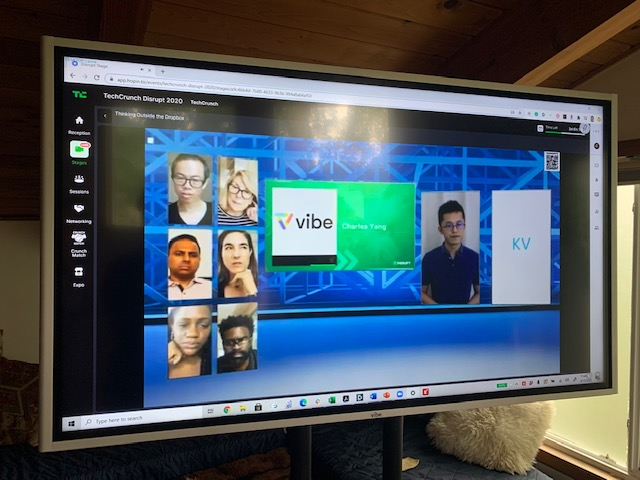Today was a big day for Vibe. Out of thousands of startups, Vibe was chosen for a slot at Startup Battlefield, an event that TechCrunch has held as part of its Disrupt event for the last ten years.
As TechCrunch notes, “The competition is stiff. The selected startups have undergone a rigorous application process, with a 2% acceptance rate. This year’s batch is exceptional.”
Most of the 20 companies had months to prepare. We were a Wildcard team, which means that we had less than a week.

With our CEO, Charles Yang, presenting from Hangzhou, China, and Katie Kalafus, Head of Sales, doing the demo from Seattle, Washington—and a 15 hour time difference—this was no easy task. Fortunately, we all have Vibe Boards to help us build the presentation and sync over video conference.
Since we only had six minutes to present and a very short amount of time to answer the judges’ questions, we wanted to go into more depth here.
TechCrunch Judge, Amish Jani, FirstMark Capital –
Seems like a crowded landscape with Miro and Mural; are you targeting a different segment or a specific vertical?
The products are simply different. Miro and Mural focus on PC online whiteboarding services, so they’re built with a keyboard and mouse in mind. Vibe’s entire user interface is built around using a touchscreen and stylus. Handwriting and drawing have long been favored for brainstorming and collaboration sessions because they unlock deeper thinking.
The buyer journey is also different. Our hardware can be used by people within different industries, scenarios, and experiences. And with Vibe, you can do way more than just whiteboarding—there is simply more potential for new services.
TechCrunch Judge, Monique Woodard, Cake Ventures –
You have hardware/whiteboard, you have software – have you thought about creating community?
We haven’t started an official community, but our customers are already sharing content that they’ve created with Vibe. In particular, we see high-level consultants in sales, marketing, and finance using Vibe to present to their prospective clients via YouTube or other platforms. Teachers are also creating shared libraries of materials to use across their classrooms.
TechCrunch Judge, Jessica Verrilli, GV –
Does anyone use the product in single-player mode or is it collaborative?
Vibe was designed for local and remote collaboration, but many of our customers use Vibe by themselves to brainstorm and sketch out ideas, just like they would on a standard whiteboard. Vibe layers on benefits like an infinite canvas, multiple boards, cloud-based service to access boards from anywhere, and being able to pull in any files you like for annotation.
Customers also screencast to Vibe for a second monitor and can even show 3rd party apps like Netflix or YouTube for entertainment.
TechCrunch Judge, Erik Moore, Base Ventures –
How do you go up against more established competitors? Is it a marketing problem?
It’s a crowded space but it is still an unsolved problem. No one has solved the problem yet, so that’s why we had to build Vibe.
It is fundamentally a product problem. The big players are so far from customers and their core business that they do not have the efficiency/determination/vantage point to solve this problem for them. Selling through channels loses the connection with customers. That can work for hardware, but for SaaS businesses, it’s a losing proposition. Vibe’s direct connection to our end-users means that we’re constantly learning from their desires and behaviors to make our products even better.
The marketing environment and user needs have changed and established competitors are building out from the same channel marketing strategies that they’ve held for 30-40 years. Vibe’s direct to consumer model revolves around our customers, and our digital marketing showcases the opportunities presented by Vibe’s open app ecosystem. We want customers to use our platform in the way that’s best for them, and not lock them into Microsoft or Google applications, or limited choices.
Vibe is filling a big need for many businesses, and at a much lower price point. Vibe Board is $2,999. In comparison, Google Jamboard is $4,999 with a $600 annual subscription, Cisco WebEx Board is $4,990 with a $199 monthly subscription, and the Microsoft Surface Hub is $8,999 and relies on an Office 365 subscription.
Vibe offers a collaborative solution combining an interactive digital whiteboard and innovative smart software. Increase engagement and efficiency at your brainstorming sessions, virtual training, and classroom sessions by integrating your favorite applications with video conferencing and an infinite, mess-free writing canvas! Collaborate today with Vibe.
Looking for the latest in interactive whiteboard technology? Check out Vibe today!
